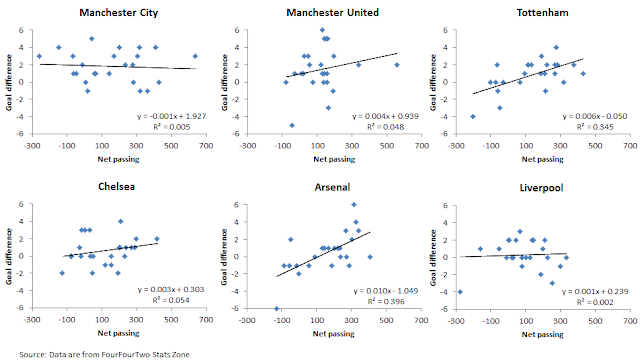The figures below plot net passing against goal difference for each of the members of the big six (the bivariate regression is estimated using OLS). For clubs that rely on passing and possession to build goals, we would expect a positive relationship between net passing and goal difference. In other words, we would expect that as a team completes more and more passes than an opponent, the team's goal difference increases. For teams that rely more on a counter-attacking style of play, we would not expect a discernible relationship between net passing and goal difference.
(Click to enlarge)
For Manchester City and Liverpool, net passing explains less than 1 percent of the variation in goal difference (R2=0.005 and R2=0.002, respectively). Net passing explains about 5 percent of the variation in goal difference for Manchester United and Chelsea (R2=0.048 and R2=0.054, respectively). For the North London clubs, however, net passing explains considerably more of the variation in goal difference. Remarkably, about 35 percent of the variation in Tottenham's goal difference is explained by net passing (R2=0.345), and nearly 40 percent of the variation in Arsenal's goal difference is explained by net passing (R2=0.396). Not surprisingly, the coefficient on net passing is statistically significant only in the Arsenal and Tottenham models (p<0.01). For Arsenal, each additional 100 passes completed more than the opposing team is associated with nearly a 1 goal increase in goal difference. An increase of the same size in net passing for Tottenham is associated with a 0.6 goal increase in goal difference.
In sum, there is a strong relationship between net passing and goal difference for Arsenal and Tottenham, a weak relationship for Manchester United and Chelsea, and no apparent relationship for Manchester City and Liverpool.
In sum, there is a strong relationship between net passing and goal difference for Arsenal and Tottenham, a weak relationship for Manchester United and Chelsea, and no apparent relationship for Manchester City and Liverpool.


No comments:
Post a Comment
Please participate in the discussion.